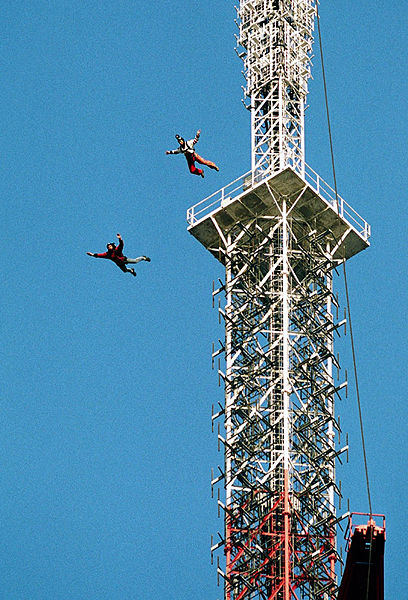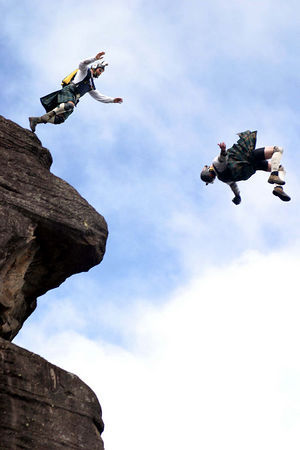
BASE jumping or also known as base jumping or basejumping, is an activity that uses a parachute or the use of a wing suit and a parachute at the same time. In BASE jumping you jump from fixed objects, with the parachute unopened at the jump. The word BASE is an acronym that stands for the four fixed objects which one can jump from: building, antenna, span, earth. This acronym was originally made by Carl Boenish. He was the real catalyst behind modern BASE jumping, and in 1978 filmed the first BASE jumps to be made using ram-air parachutes and the freefall tracking technique. BASE jumping is seen as more dangerous than skydiving from aircraft, and is seen by many as a fringe extreme sport or stunt. Phil Smith and Phil Mayfield attained the exclusive BASE numbers of, BASE #1 and BASE #2 when they jumped from a Houston skyscraper together on January 18, 1981. They had already jumped from antennae, spans, and earthen objects. Jean and Carl Boenish later qualified for BASE numbers 3 and 4. Later on another “award” of Night BASE was given Mayfield completed each categorized jump at night, becoming Night BASE #1. Smith soon qualified also.
In the early 80’s all the BASE jumping was completed with standars
skydiving equipment, including two parachutes, one main and one reserve,
and deployment components. Later on, specialized equipment and techniques
were developed that were designed specifically for the unique needs of
BASE jumping.
Louis Sebastien made the fist parachute jump from the tower of the Montpellier
observatory in 1783. Frederick Law jumped from the Statue of Liberty in
1912. Also in 1912 Franz Reichelt, jumped from the first deck of thee
Eiffel Tower testing his coat parachute invention. It was his first ever
attempt with the new parachute, and he ended up dying. On 9 November 1975,
the first person to parachute off the CN Tower in Toronto, of the tower's
construction crew Canada, was Bill Eustace, a member. Due to this, he
was fired. In 1975, Owen J. Quinn, a jobless man, parachuted from the
south tower of the World Trade Center to publicize the plight of the unemployed.
In 2008, two men, dressed as engineers, illegally jumped off the Burj
Dubai, the tallest man-made structure in the world. After 1978, the filmed
jumps from El Capitan were repeated, not as a publicity exercise or as
a movie stunt, but as a true recreational activity. It was this that popularised
BASE jumping more widely among parachutists. Carl Boenish continued to
publish films and informational magazines on BASE jumping until his 1984
death after a BASE-jump off of the Troll Wall. By this time, the concept
had spread among skydivers worldwide, with hundreds of participants making
fixed-object jumps.




Difference
Between BASE Jumping and Skydiving
BASE jumping grew out of skydiving. BASE jumps are made from much lower altitudes than skydives. BASE jumps also take place in close proximity to the object serving as the jump platform. Because BASE jumps generally entail slower airspeeds than typical skydives (due to the limited altitude), a BASE jumper rarely achieves terminal velocity. This is caused because higher airspeeds enable jumpers more aerodynamic control of their bodies, as well as more positive and quick parachute openings, the longer the delay, the better.
Skydivers use the air flow to stabilize their position, allowing the parachute
to deploy cleanly. BASE jumpers, falling at lower speeds, have less aerodynamic
control, and may tumble. The attitude body at the moment of jumping determines
the stability of flight in the first few seconds, before sufficient airspeed
has built up to enable aerodynamic stability. On low BASE jumps, parachute
deployment takes place during this early phase of flight, so if a poor
"launch" leads into a tumble, the jumper may not be able to
correct this before the opening. If the parachute is deployed while the
jumper is tumbling, there is a high risk of entanglement or malfunction.
The jumper may also not be facing the right direction. Such an off-heading
opening is not as problematic in skydiving, but an off-heading opening
that results in object strike has caused many serious injuries and deaths
in BASE jumping.

